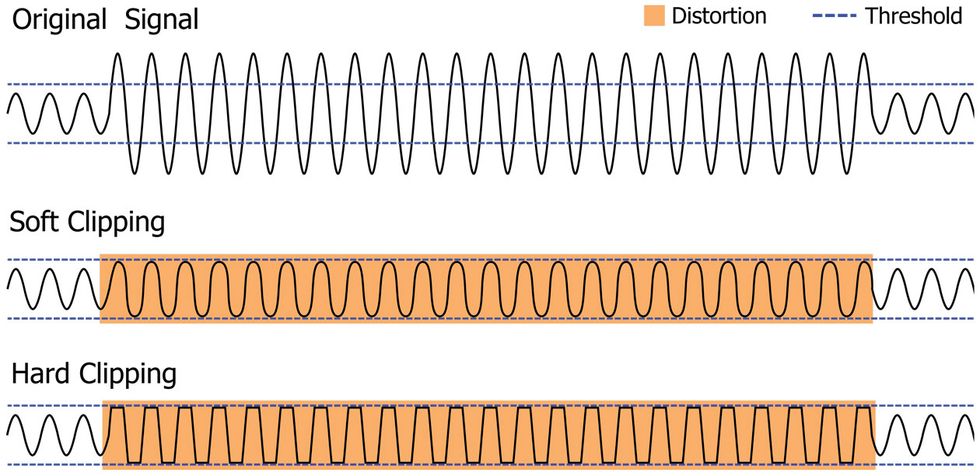Last time out, we began exploring the pros and cons of bass pedals, and then took a close look at compressors—perhaps the most useful effect for a bassist.If you're still disoriented by the concept of compression, take a deep breath: It doesn't get any easier when we investigate different types of distortion effects.
Although the sonic goal of a distortion device is radically different from a compressor, there are similarities between the two effects. While the compressor basically “turns down" the volume once it reaches a certain level, a distortion pedal simply chops off the waveform at a designated point. Both effects add apparent sustain to your signal, but a compressor will keep the original timbre and shape of the sine waves—as long as you avoid extreme settings, of course—while distortion is not so polite. When the peaks of the sine waves get clipped, they turn squarish, as seen in Fig. 1. While all distortion devices do this, they differ in how fast they react to the peaks and how they treat the signal once it gets clipped.
Another similarity between compressor and distortion effects? We bassists should avoid using the dirt pedals favored by our guitar-playing compadres. Now, when bassists ask me whether they can use their mates' distortion stomps, I reply, “Of course you can!" When it comes to music, I suggest ignoring any advice that contains the word “always" or “never." That said, there are good reasons our bass-specific variants exist—and this applies even more to distortion devices than to compressors.
A distortion device adds upper harmonics, and the more it does this, the more likely it is to blur and diminish the low end. That's why our bassversions of distortion effects sport an option to blend in the original signal, or specify frequency range that gets distorted, or even include an integrated octave circuit to compensate for low-end loss.
The days when we could easily divide grit into three categories are long gone, but these classifications are still helpful.
• Overdrive can be described as the warm sound of a tube power amp under moderate strain.
• Distortionis a more aggressive and edgy variant of overdrive that results from a slammed preamp. It's easy to imagine why it's harsher: The earlier you alter the tone, the more dramatic the sonic outcome as the sound gets processed in successive stages of your signal chain.
• Originally based on the sound of a solid-state amp in meltdown,fuzzhas the finesse of a chainsaw. When it comes to quickly clipping off the peaks of sine waves, fuzz devices are champs.
Today, the differences between these categories—particularly overdrive and distortion—are less distinct, but if you're looking for the nastiest results, fuzz remains the weapon of choice.
It's a bit ironic that bassists use distortion effects today. In the early years of stringed-instrument amplification, the sonic goal was to create a clear, but louder, version of a given acoustic instrument. Bassists especially were plagued by unintended distortion that originated from overstressed amps and weak cabinets.
But that soon changed: By the mid 1960s, distortion had returned as a desirable color in a bassist's sonic palette—especially in some successful studio recordings. Producers learned that laying distortion over a separate clean bass signal added to the growl of the whole band's sound, and the listener could only hear it as a distinct effect in a few parts of a song where the bass was exposed. Of course, modern low-enders aren't shy, and we can hear distorted bass in almost every musical genre and at every level of sonic dominance—it's no longer relegated to the background.








![Rig Rundown: AFI [2025]](https://www.premierguitar.com/media-library/youtube.jpg?id=62064741&width=1245&height=700&quality=70&coordinates=0%2C0%2C0%2C0)












 Shop Scott's Rig
Shop Scott's Rig


![Rig Rundown: Russian Circles’ Mike Sullivan [2025]](https://www.premierguitar.com/media-library/youtube.jpg?id=62303631&width=1245&height=700&quality=70&coordinates=0%2C0%2C0%2C0)












































